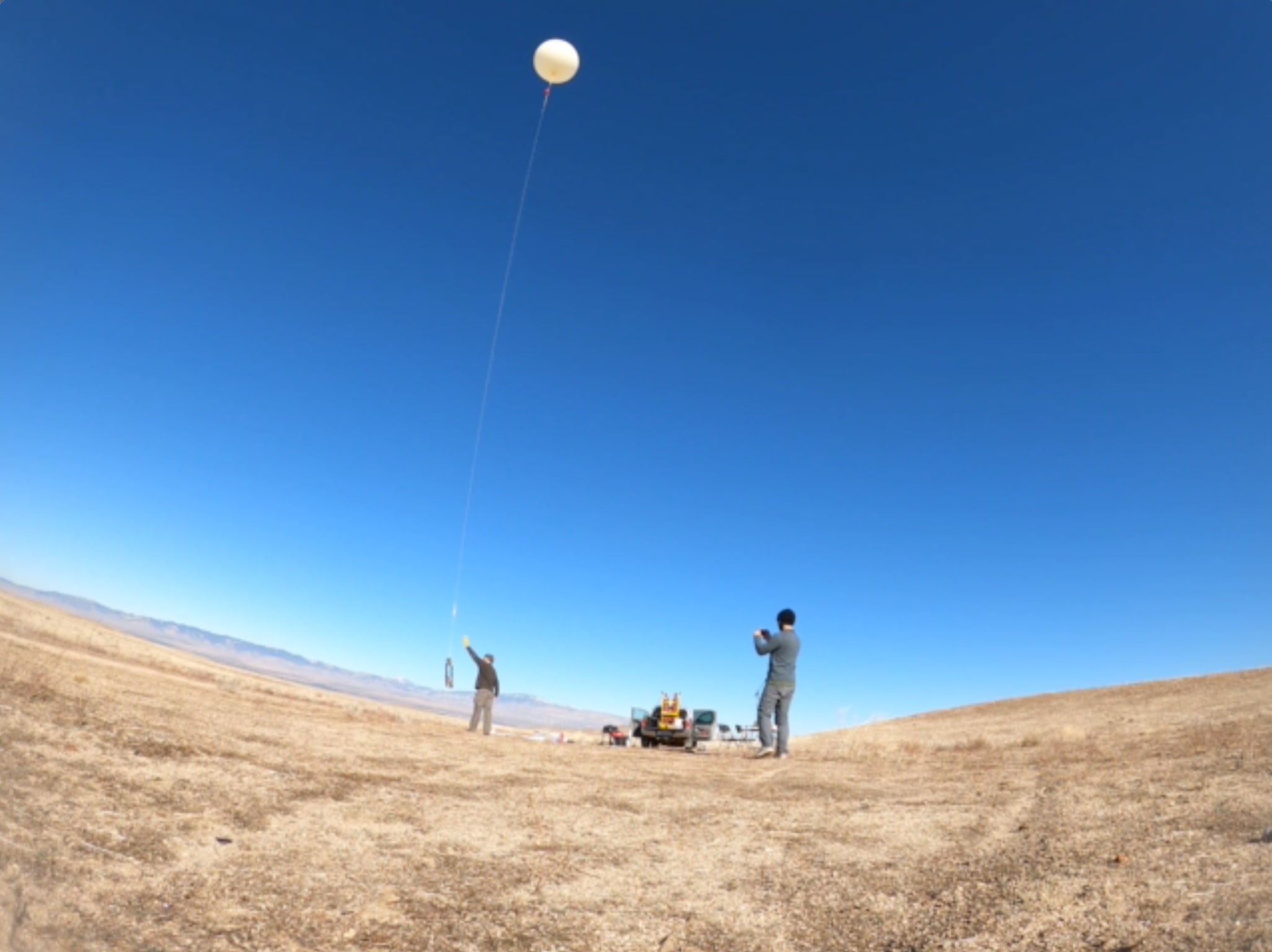Balloon Flights
High-altitude Balloon Flights Improve Calibration Standards
High-altitude balloon flights are the most accurate and cost-effective means to determine the AM0 performance of solar cells. Historically, these flights have been accomplished with large balloons that are expensive, cumbersome and feature long wait times — cutting into research and manufacturing project schedules.
Small balloons offer the accuracy advantages of their larger counterparts and their agility enables more flights to be scheduled per year at lower cost than most lab measurements.
Flight Hardware
Measurement Electronics
The Aerospace Measurement Unit (AMU), designed by the Aerospace Corporation, is a highly capable and low-cost current-voltage (IV) and temperature measurement platform. It is designed to make solar cell measurements pre-, mid- and post-flight.
Integrated temperature reading allows the AMU to simultaneously measure cell temperatures and IV characteristics. The AMU supports both USB and I2C queries and features a small amount of memory to store AM0 cell performance data, which is available while the cell is being used.
Cell Holder Designs
Solar cells must be mounted to a gondola on a balloon before being flown. This is typically done by mounting the cell directly to a cell holder printed circuit board (PCB). Cell holders are typically one of two standard styles, each with its own benefits and challenges that should be considered to determine the best fit for a given application. Non-standard or custom cell holders are also an option.
NSCAP
U.S. government agencies including NASA, Air Force and Navy Research Lab collaborated on the Near Space Calibration of Advanced Photovoltaics (NSCAP) program to develop the NSCAP cell holder. The NSCAP cell holder is available off-the-shelf to accommodate most 2 by 2, and 4 by 8 centimeter cell sizes.
This cell holder is designed with an aluminum backplate that is mounted to an FR4 PCB and is in direct contact with the cell to increase thermal mass and conductivity. An optional RTD or AD590 temperature sensor can be embedded directly into the backplate. The temperature sensor’s analog pins and four-wire electrical connection to the cell are broken out into the PCB connector.
AMU
The AMU cell holder is designed to accommodate an AMU soldered directly to it, allowing the IV electronics to follow the cell from pre-, mid- and post-flight measurements. This cell holder design consists of an aluminum-core PCB with a surface-mounted RTD sensor placed directly adjacent to the cell. The AMU cell holder is available off-the-shelf and can carry 2 by 2 and 4 by 8 centimeter cells.
Custom Payloads
Balloon gondolas can be designed to accommodate a wide range of payload form factors including custom cell sizes and cell holders.
Baffles
Cell baffles minimize the impact of stray light on cell measurements during the balloon flight. Without a baffle, albedo from Earth's atmosphere and sunlight reflections from the balloon can artificially increase cell incident irradiance. Baffles are designed with a maximum acceptance angle of 5 degrees. The baffle’s geometry prevents light at angles above 5 degrees from entering the baffle and reaching the cell.
Balloon Flight Applications
Generating Solar Simulator Reference Standards
No solar simulator perfectly matches the sun’s AM0 irradiance and spectrum. Flying solar cells on balloons allows for direct AM0 performance measurements. Once cells are returned from their flight, they can be used as calibrated reference standards to calibrate and validate the output of a solar simulator. This procedure is particularly important to multi-junction cells because poor sub-junction current match can cause significant measurement errors. Balloon-flown calibration standards are the most accurate method of solar simulator calibration.
The AIAA S-111 and S-112 solar cell testing standard specifically recognizes this importance by requiring +/-1% sub-junction current match instead of the ASTM E927 spectral match requirement.

AM0 Performance Measurements
Balloon Measurements
During the flight, cell performance is measured from about 70,000 feet (21 km) to over 110,000 feet (33.5 km). This portion of the flight is when the cell experiences a temperature increase from about -20 C to approximately 30 C. During this time, AM0 Isc and Voc are measured as well as the current-temperature and voltage-temperature coefficients. Additionally, full IV curves are measured during the flight which allows critical cell AM0 characteristics, such as fill factor, to be calculated.
After the flight, data is collected and processed to generate true AM0 measurements that are corrected for temperature, mean Sun-Earth distance and irradiance-incident angle as well as ozone spectral correction (if a QE plot is provided).
Direct Comparisons Between Technologies
Balloon flights are a great way to directly compare the true AM0 performance differences between solar cells because comparison cells are flown in the same conditions on the same balloon — allowing for direct comparisons.
Different technologies, iterations or manufacturing lots can be flown on the same balloon flight as well as cells at beginning of life (BOL) and cells irradiated to the expected end of life (EOL) degradation of a particular mission. And since balloon flights are low-cost and accessible, they enable quick turnarounds to iterate new cell technologies or make BOL/EOL measurements.
© 2025 Angstrom Designs | Privacy Policy